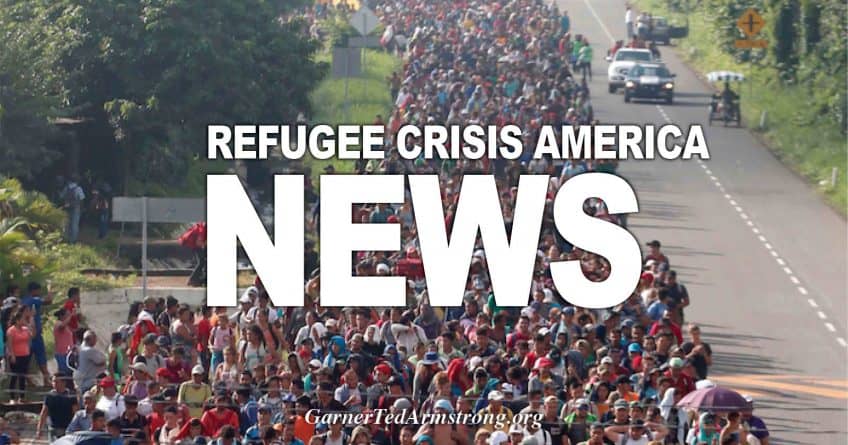
A Guatemalan migrant and his son cross to the United States, via the Rio Grande natural border between El Paso and Ciudad Juárez in Mexico, in search of political asylum. (Herika Martinez/AFP/Getty Images)
Republican critics of Biden say the new wave is the start of the crisis they have long predicted, invited by the new administration’s eager rejection of Trump’s deterrent approach. Yet Biden also inherited a highly improvised enforcement system from his predecessor that was already under strain and highly dependent on Trump’s diplomatic bullying of Mexico.
Late last month, Mexican authorities in some areas of the border stopped taking back families returned by the United States under emergency pandemic health measures implemented last March. With the U.S. capacity to hold adults and children reduced by the pandemic and the temporary closure of the largest Border Patrol facility in South Texas, U.S. Customs and Border Protection began dropping families off at bus stations and shelters last week.
“I came last year, but they weren’t giving you the opportunity to cross. But then I decided to come back again, and thank God, I got the opportunity,” said Daysi Funes Peña, 40, who arrived with her three children Thursday night.
Last fall, she crossed the Rio Grande with her family and surrendered to border officials, but they were returned to Mexico, she said. This time, Funes Peña and her children were released in downtown McAllen and into the care of the Catholic Charities of the Rio Grande Valley.
The area has been one of those hit hardest by the coronavirus pandemic, with more than 100,000 cases, raising concerns in cities and towns worried about a growing influx of people and outbreaks inside shelters. CBP officials do not test migrants for the coronavirus, but the state of Texas last week sent extra kits to border communities.
A group of 166 adults and children arrived in the Rio Grande Valley on Thursday night, followed less than an hour later by a group of 87, according to CBP. Since then, additional groups of more than 100 have been taken into custody in the same area, according to a CBP official who was not authorized to discuss the incidents.
Homeland Security officials have not said how many adults and children they have released since Mexico stopped accepting some family groups. They have described the releases as mostly limited to the Rio Grande Valley of South Texas, but shelter operators in the Laredo and Del Rio areas, as well as in San Diego, have reported a sudden upturn in the number of people released by CBP needing care.
“In some instances, certain family units in a small fraction of the border have not been able to be returned to their last point of origin,” Matt Leas, a spokesman for the Department of Homeland Security, said in a statement. “As Customs and Border Protection always has, it adjusts resources as needed to meet the demand at the border and regularly screens individuals for signs of health issues when they are encountered, including covid-19. Anyone who shows sign of illness receives the appropriate medical treatment.”
CBP typically releases families in its custody because U.S. courts have ruled that underage migrants cannot be held in adult immigration jails. Parents who arrive with children are generally issued an order to appear in court and released into the interior of the United States.
The Trump administration tried to deter families with its Zero Tolerance crackdown in 2018, which separated more than 3,000 children from their mothers and fathers before it was halted amid public outcry.
Border crossings soared after that, until Trump used tariff threats to coerce Mexico into helping the United States crackdown. Mexico began accepting Central American families sent back by U.S. authorities and made to wait outside U.S. territory while their humanitarian claims were processed by U.S. courts. That program, known as the Migrant Protection Protocols, left thousands of families living in squalid tent camps along the Rio Grande, and Biden is suspending it.
Starting last March, the Trump administration turned to a different enforcement tool, known as Title 42, that allowed U.S. agents to rapidly “expel” most recent border crossers to Mexico. But after barely a week of Biden’s presidency, Mexico has started refusing the return of some families, citing a new law that went into effect last month requiring children to go to family-appropriate shelters.
The Mexican government released a statement Saturday acknowledging that it had “made some adjustments in recent days” due to the implementation of its new law, but it said there had been no broader policy change.
Across northern Mexico, migrants waiting along the border debated what to do. Some had read news stories about families crossing the Rio Grande and being released into the United States. Contradictory rumors swirled on WhatsApp groups.
Some parents were torn: Was it worth the risk of swimming across the river with their children, or should they wait until a more formal policy emerged? What if that policy never came?
“I don’t know what to do,” said Glenda, a 38-year-old from northern Honduras who was waiting in Matamoros with her two children, ages 2 and 5. “There are rumors and people have it in their head that if they swim across they’ll get a permit to live in the U.S., but I can’t tell if it’s real.”
She had been waiting in Matamoros for over a year for the chance to apply for asylum in the United States. Each time she had approached immigration officials on the international bridge, she was told to wait. In October 2019, she decided to send her 16-year-old son across the bridge alone, so that he would be processed as an unaccompanied minor, making it harder for officials to turn him back. He’s now in a San Antonio foster home.
There are over 20,000 outstanding MPP cases along the border, more than 5,000 of them in Brownsville, according to an analysis from the University of Texas. Even though Biden has suspended the policy, it remains unclear when and how those asylum seekers will be brought to the United States for their cases to be processed. Many of them have endured violence and extortion while waiting in Mexico. Some have decided that swimming across the river is now worth the risk.
Biden administration officials in recent weeks have issued public statements urging migrants not to make the journey north. But current and former CBP officials say the president’s other moves to rescind Trump-era controls, welcome immigrants, and curtail deportations risk incentivizing a new migration wave in Central America, which has been hit hard by natural disasters and the financial blow of the pandemic.
Secretary of State Antony Blinken on Saturday announced the cancellation of another Trump-era program, known as Asylum Cooperation Agreements, that allowed U.S. authorities to send asylum seekers back to Central America to find refuge there.
“I think we’re just sending the wrong message in rescinding all these executive actions,” said Rodolfo Karisch, a retired Border Patrol official who was chief in the Rio Grande Valley in 2019. “I think we’re asking for additional chaos similar to what we saw in 2019,” he said.
“This could cause a huge problem for these communities along the border, because we still have significant challenges with covid, and this looks like a recipe for something that isn’t good,” Karisch said.
Last summer, Enedina Treviño, and five family members caught the virus. Her mother-in-law died from it.
Treviño was alarmed by the news of migrants being released untested in nearby McAllen. There was still a risk, she said, even if the migrants are tested soon after they arrive.
“I know they come here to better themselves, but it’s still a danger to us — a community who is still suffering from covid, still suffering the aftereffects,” said Treviño, who has been dealing with the lingering effects of the disease that she said put her in the hospital just two weeks ago.
Many of the Central American families reaching the border have been traveling long distances in cramped quarters, at greater risk of exposure.
Inside the McAllen shelter where Funes Peña and her children arrived after their release by CBP, kids wearing blue surgical masks chased each other. Posters hung around the large room, labeling stations for “Personal Hygiene” and “Registration.” A map of the United States hung on one wall. Colorful children’s drawings were taped to the windows. “Here is beautiful,” read one in Spanish.
On Sunday afternoon, Funes Peña was preparing to step on a plane for the first time — the last leg of a harrowing journey from Honduras to the U.S.-Mexico border that relied on the kindness of strangers to feed and clothe her and her children.
Her 11-year-old son fed a bottle to her 3-year-old daughter, who lay half-asleep in her arms. Funes Peña’s other daughter, Andrea Marisol, 9, looked on, a strip of blue tape concealing her right eye.
The girl had been attacked in the streets of Honduras, her mother said when she was 5 years old. Funes Peña was hoping she could find better medical care for her daughter’s eye in the United States.
The family is from the rough outskirts of San Pedro Sula, and Funes Peña said they were fleeing both poverty and violence. A single mother, she worked at a factory that laid off its staff amid the pandemic, and she was left jobless and with three children to feed.
The family first left Honduras in September, arriving at the border in October, she said. They were soon returned to Mexico. They went home to Honduras.
It was on her second trip north, while she was making her way slowly through Mexico, that she received a call from a friend who had embarked on the journey to the United States a week earlier.
“She said, ‘Come, they’re really receiving mothers with children, families.’ And it was true, we made it,” Funes Peña said. “That was my goal, to make it.”
The family left immigration custody and arrived Saturday at the shelter in downtown McAllen, which provided her with clothes, shoes, and food, Funes Peña said. The next day, they were on a flight to New Jersey to start a new life.
















